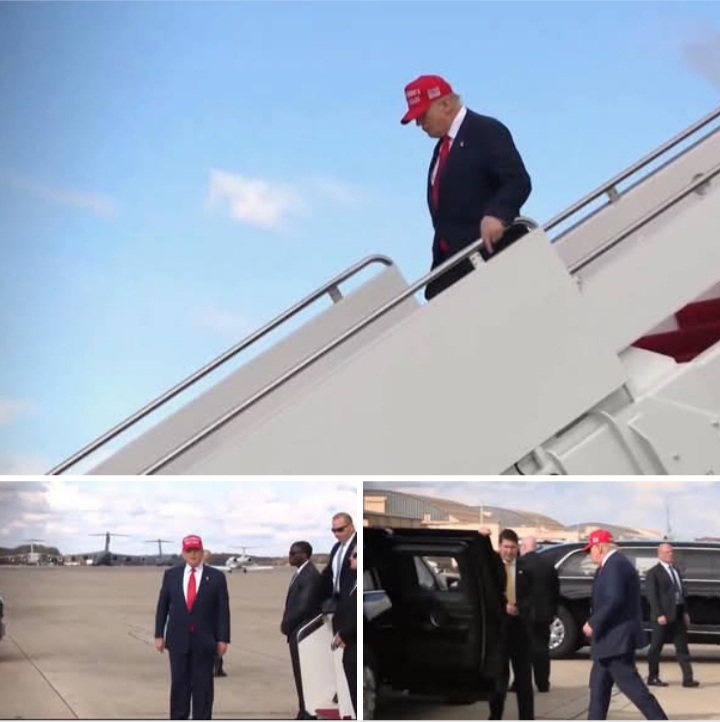CELEBRITY
BREAKING: President Trump has just arrived BACK in the United States after an incredibly successful trip to Asia. He’s in MAGA hat! 47 is bringing home nearly $2 TRILLION in trade deals and investments, China is buying up USA energy and soybeans, more critical minerals have been secured and a peace deal was signed. Up next agenda is…..full article here

BREAKING: President Trump has just arrived BACK in the United States after an incredibly successful trip to Asia. He’s in MAGA hat!
47 is bringing home nearly $2 TRILLION in trade deals and investments, China is buying up USA energy and soybeans, more critical minerals have been secured and a peace deal was signed.
HE DOES NOT STOP! Thank you for all you do, 47!
**U.S. Scores Major Wins in Trade, Supply Chains and Diplomacy**
In a striking string of developments, the United States has achieved a series of significant milestones in trade, investment and diplomacy — signalling a shift in global alignments and economic strategy.
### Nearly $2 Trillion in Trade Deals & Investments
While no single public disclosure confirms *exactly* a $2 trillion figure, several large-scale commitments underline the magnitude of recent deals. For instance, Gulf-state partners and other foreign investors have pledged multi-hundred-billion-dollar packages in U.S. energy, technology, infrastructure and defence. ([LinkedIn][1])
These deals reflect Washington’s renewed role as a hub for inward investment — not simply outward capital flows — and underscore the strategy of leveraging trade and investment for geopolitical leverage.
### China’s Renewed Buying: U.S. Energy & Soybeans
In the bilateral relationship with China, the U.S. has secured key purchase commitments. In talks held on 30 October 2025 between President Donald J. Trump and President Xi Jinping, China agreed to resume large-scale U.S. soybean purchases — a sector previously hit by trade war retaliation. ([The Business Times][2])
Moreover, China has signalled greater interest in U.S. energy supplies — part of a broader approach of diversifying its procurement and reducing strategic vulnerabilities.
### Securing Critical Minerals & Supply Chains
A major strategic win involves critical minerals and rare‐earths supply. The U.S. and China reached a one-year framework deal in which China agreed to keep rare earth exports flowing to U.S. firms, forestalling a supply‐shock in sectors such as EVs, defence and electronics. ([The Economic Times][3])
Meanwhile, Washington is diversifying its supply chains via treaties and investments with Australia, Japan and other mining jurisdictions to reduce dependence on China’s dominance. ([OilPrice.com][4])
These efforts show that “securing” critical minerals is now both an economic and national-security objective.
### A Peace Deal Adds Diplomatic Momentum
Beyond trade and supply chains, the U.S. has also helped broker a peace agreement between Democratic Republic of the Congo (DRC) and Rwanda. Signed on 27 June 2025 in Washington, the deal aims to end decades of conflict in eastern Congo, while opening avenues for investment into the region’s resource-rich economy. ([Reuters][5])
The agreement explicitly links peace and economic development, including provisions for U.S. investors to participate in mineral value-chains. The interplay between diplomacy and economics is evident.
### Why This Matters
* **For U.S. industry**: These developments signal more stable access to both raw materials and ending trade volatility with China — crucial for manufacturing, EVs, defence, and agriculture.
* **For global supply-chains**: With China committing to soybean and rare earth supply, and the U.S. seeking alternative sources for critical minerals, supply-chain resilience is shifting.
* **For geopolitics**: Investment and trade now function as strategic tools. The linking of peace-deals, resource access, and trade frameworks demonstrates a broader approach to U.S. global engagement.
* **For agriculture and energy**: U.S. farmers and energy producers stand to benefit from renewed Chinese demand; likewise, American energy exports gain a major market.
* **For the future**: The stability of these accords remains to be seen — particularly the rare-earths agreement and the peace deal — but the momentum is evident.
### Some Caveats
* Figures such as “$2 trillion in deals” should be taken as approximate — many individual deals remain non-public or approximate.
* The rare-earth and soybean commitments, while real, may not yet have full implementation or transparent volume disclosures.
* Peace-deal success depends on enforcement, follow-through and inclusive reconciliation; past agreements in the region have faltered.
* China’s purchase commitments may still be politically and economically contingent — behaviour in previous rounds of U.S.–China trade talks shows some gaps between promise and delivery. ([Al Jazeera












